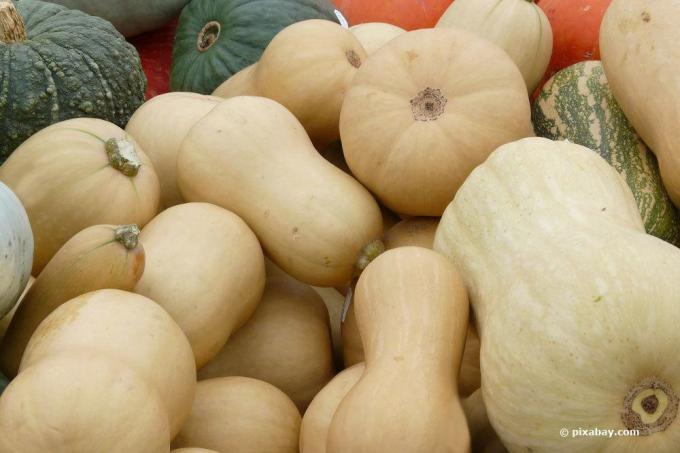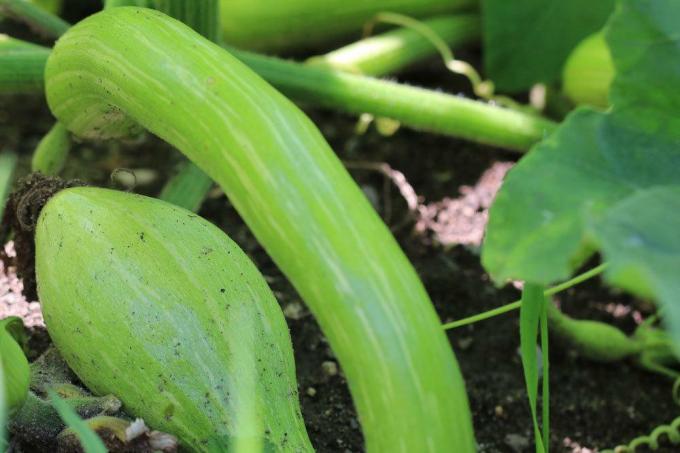
table of contents
- Nutmeg Pumpkin
- Maturity
- Knock test
- Pumpkin harvest
- immaturity
- Frost before harvest time
Nutmeg pumpkin from our own cultivation spoils the palate as an aromatic pumpkin cream soup, spicy chutney, hearty side dish or sweet cake topping. The home gardener gourmet knows that only ripe fruit can provide perfect enjoyment. This guide is packed with in-depth information on the best harvest time. Benefit from our tips on how you can accelerate the ripening process in the bed or bring unripe fruits behind glass to the point where they are ready for consumption. This is how you can determine the state of ripeness beyond any doubt and harvest the nutmeg squash correctly.
Nutmeg Pumpkin
The maturation period is 120 to 150 days
Nutmeg squash forms a subgroup of the popular ones Musk gourds (Cucurbita moschata). The most famous representative is the historical variety "Muscade de Provence"which is mainly grown in southern Europe. The close relationship is not only expressed in the bronze-colored, juicy-sweet flesh, but also in a corresponding ripening time of 120 to 150 days. Since the time window for direct sowing in the Central European climate does not open until mid-May, the harvest time extends from mid-October until the first frost. This information is based on the premise of ideal framework conditions in a sunny, warm location. Above all, the weather determines when the fruits are ripe and when the harvest time actually begins.
Maturity
When is a pumpkin ripe? - That's how you find out
It would be so easy to count the days after sowing to know when to start harvesting. The imponderables of the Central European summer weather thwart this plan. In fact, the indication of the ripening time for all types of pumpkin only serves as a guide. This is mainly for harvesting „

„ of importance, since this variety needs a lot of warmth and does not always reach full maturity even in its Mediterranean distribution area. An uncomplicated test procedure can be used to reliably determine whether the fruit is actually ripe. The following criteria indicate when you can harvest a nutmeg squash.
- smooth, intact, light brown to bronze colored skin
- completely colored, without green spots
- firm, woody fruit stalk
Knock test
Of the Knock test provides final certainty that a nutmeg pumpkin is ripe. If all optical requirements are met, put one ear to the bowl and tap the fruit. When a hollow, dull noise sounds, the harvest can begin. As long as you cannot approve a single criterion for harvest maturity, please leave the fruit in the bed. If you harvest the tank berries too early, the shelf life, taste and aroma will suffer.
Pumpkin harvest
Instructions for the pumpkin harvest
Fully mature Nutmeg Pumpkins weigh up to 20 kg, which makes harvesting a feat of strength. At the same time, a high degree of tact is required if you want to harvest the heavyweight without damage. Minimal damage to the skin or the sensitive fruit stalk causes rot or serves as a welcome target for pathogenic germs. The following instructions explain step by step how to professionally harvest a nutmeg pumpkin.
- on a day with dry, overcast weather before the first frost
- Sharpen and disinfect knives or secateurs
- place a sufficiently large wheelbarrow next to the ripe pumpkin
- harvest the fruit with a smooth cut
- Do not break off the stem
- Leave at least half of the woody stem on the fruit

Lift the pumpkin into the wheelbarrow. If the armored berry has reached its proud maximum weight, a helping hand is welcome so that the splendid specimen does not fall to the ground and break at the last moment.
immaturity
Nutmeg squash is not ripe - what to do?
A cool, rainy summer makes all information about the ripening period obsolete. If there is a lack of heat and sunlight, the pumpkin will achieve the expected diameter of 30 to 40 cm and a weight of up to 20 kg as it grows. The skin, on the other hand, remains dark green and soft. You can promote the maturation process with a targeted strategy.
That is how it goes:
- stop watering and fertilizing the pumpkin plant
- Cut off all roots with a sharp spade within a radius of 50 to 60 cm
- put the fruit on a wooden board to protect it from rot
These measures set in motion an accelerated ripening process in the pumpkin. It is important to note that this is an emergency plan that only works on fully grown nutmeg pumpkins.
Frost before harvest time
Onset of winter before the start of harvest - this is how you act correctly
The package of measures to accelerate maturity is a hopeless undertaking when it is freezing and snowing. Like all cucurbits, nutmeg squash cannot tolerate temperatures below freezing. Still, this year's pumpkin harvest is not doomed because "Muscade de Provence" is one of the climacteric fruits. This property means that an unripe pumpkin can ripen after it is harvested. Special metabolic processes mean that the stored starch is also converted into fructose outside the cultivation area. The natural plant hormone ethylene plays a key role in this. This puts the nutmeg squash on a par with other climacteric fruits such as apples, pears, tomatoes or plums.

This is how it works:
- Before the first frost, harvest all unripe pumpkin fruits
- Spend the pumpkin in a bright location with temperatures of 20 to 25 degrees Celsius
- Place fruits next to each other without touching them and do not stack them
- Turn every few days until fully ripe
The plant hormone Ethylene is also known as ripening gas because it escapes climacteric fruits and affects surrounding fruits across species boundaries. If you place a few fully ripe apples, pears or bananas next to a pumpkin, the ripening process will proceed quickly. When a nutmeg pumpkin is ripe for consumption during the climacteric period, the warm bronze tone of the skin color and a knock test reveal.



